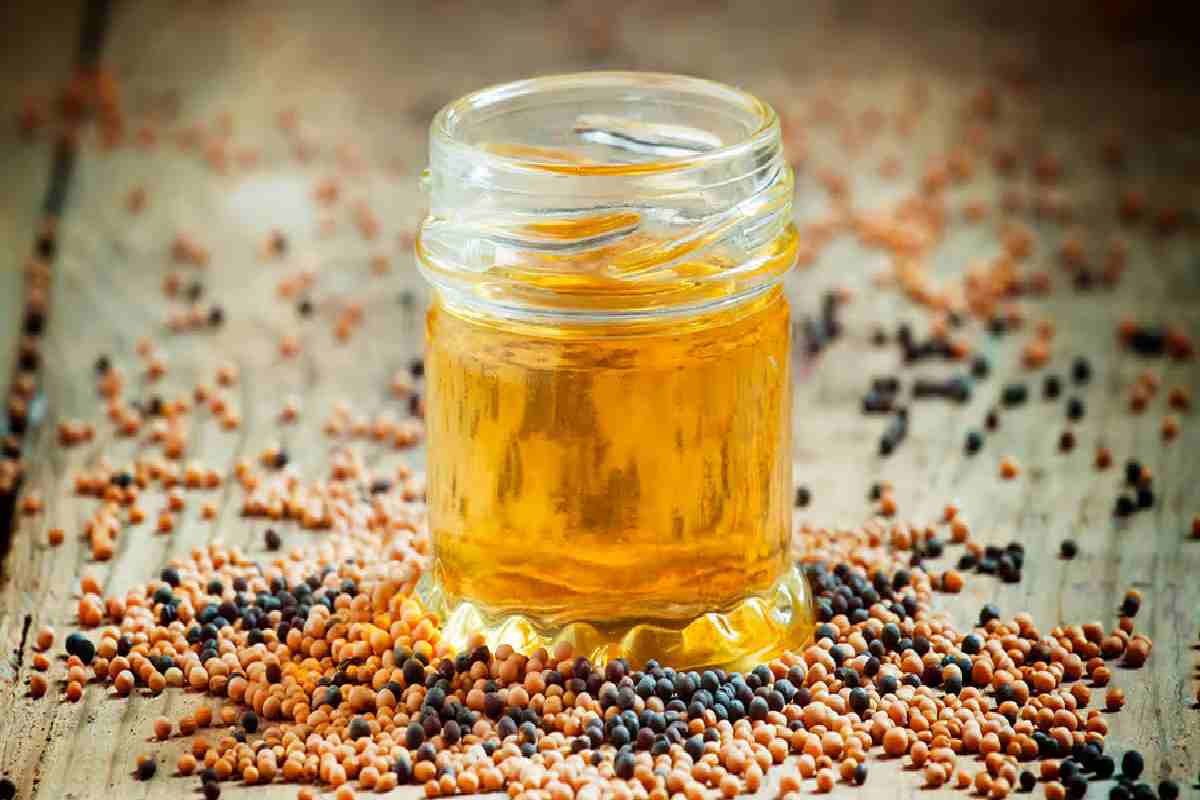Table of Contents
Mustard Oil Identity Card
- Botanical names: Sinapis alba (white mustard), Brassica nigra (black mustard), Brassica juncea (brown mustard)
- Botanical family: Brassicaceae
- Producing plants: White mustard, brown mustard, black mustard
- Origins: Asia, Europe, America, North Africa,
- Part of the plant extracted: Seeds
- Oxidative potential: Little sensitive
Mustard seeds are used to manufacture a famous condiment and the production of vegetable oil. Still unknown in Europe, mustard oil is renown in India and Africa for its beneficial properties for the hair. And also, it used to prepare several hair care products. And also especially for frizzy, curly or brittle hair, this vegetable oil is ideal for strengthening hair, promoting hair growth and limiting hair loss. Sometimes, it is also added to certain massage oils to stimulate and heal the skin.
Organoleptic properties of mustard oil
Botanical and organoleptic particularities will likely change depending on production conditions. (country, sunshine, organic production, etc.). However, good organic mustard oil generally has the organoleptic properties presented below.
Colour: Golden yellow
Smell: Pungent
Texture: Thick and viscous
Taste: Inedible
Composition of Mustard Oil
The production conditions strongly influence the composition of vegetable oil. Therefore, to ensure its quality, it is recommended to select an extra virgin oil obtained by cold pressing. In addition, specialists generally advise choosing an organic mustard oil.
To find out more about nutritional qualities (types of vitamins, concept of unsaturated. And also saturated and trans-fatty acids), consult the practical guide to vegetable oils.
Fatty acid composition:
- Polyunsaturated fatty acids: 12-21% linoleic acid (omega-6), 8-14% alpha-linolenic acid (omega-3)
- Monounsaturated fatty acids: 25-55% erucic acid, 8-33% oleic acid (omega-9), 6-12% eicosenoic acid (omega-9)
- Saturated fatty acids: 2-4% palmitic acid, 0.8-1.5% stearic acid
Other active constituents:
- Allyl isothiocyanate
- Tocopherols
- Carotenoids
Ways to use Mustard Oil
- Cutaneous use
- Anointing, massage, local application.
- Possible combination with essential oils. And also consult the guide to essential oils.
- And also nutritional use
- In Europe, mustard oil is used exclusively for external use. Indeed, it is not considered edible due to its high erucic acid content.
The Cosmetic Aspect of Mustard Oil
However, Mustard oil is used to prepare various hair care products. It has the advantage of strengthening the hair. And also promoting its growth and fighting against hair loss. This vegetable oil also has a toning and warming effect on the skin, making it attractive to prepare massage oils for athletes.
Main Benefits
- Stimulating and fortifying hair
- Sheathing and nourishing hair
- Anti-hair loss
- Warming effect on the skin
- Firming effect on the skin
- Venotonic (blood stimulant)
Other Benefits
- Anti-dandruffCutaneous indications (skin and hair)
- Tired, dull skin
- Muscular comfort (before and after exercise)
- Tired, limp, dull hair
- Dry, damaged, brittle hair
- Kinky, curly hair
- Hair loss, alopecia
- Pediculosis of the scalp (lice)
Practical tips
Moreover, Mustard oil can use with other vegetable oils (coconut, castor, avocado, argan, jojoba, chaulmoogra, etc.) and several essential oils (Bay Saint Thomas, grapefruit, Atlas cedar, rosemary, laurel noble, etc.). An example of preparation is shown below. In case of doubt, it suggests approaching a specialist.
Oil bath to stimulate hair growth
- Mix the vegetable oils below:
- One tablespoon of castor oil
- One teaspoon of mustard oil
- One teaspoon of coconut oil
- Gently apply the mixture to the entire scalp and hair.
- Massage, and wrap the hair in a towel to keep it warm.
- Authorization on for 15 to 30 minutes, then rinse with a mild shampoo
Storage method: away from heat and light.
Shelf life: refer to the expiry date indicated on the bottles.
The nutritional aspect of mustard oil
In Europe, is use orally due to its high erucic acid content? However, it should note that research is currently underway to identify low-erucic acid mustard varieties.
Precautions for the use of oil
Due to its high erucic acid content. This vegetable oil uses exclusively on the skin and hair. Therefore, its use is reserve for adolescents and adults.
However, the application of mustard vegetable oil is recommended on the face. Therefore, it can cause a burning sensation, tingling, and irritation on the skin or scalp. That is why it is necessary to dilute it with other vegetable oils. Likewise, it is sensible to conduct a tolerance test in the elbow fold before general application. If in doubt, it recommends pursuing the advice of a specialist. And also, Vegetable oils should be stored in a dry place away from heat and light.


